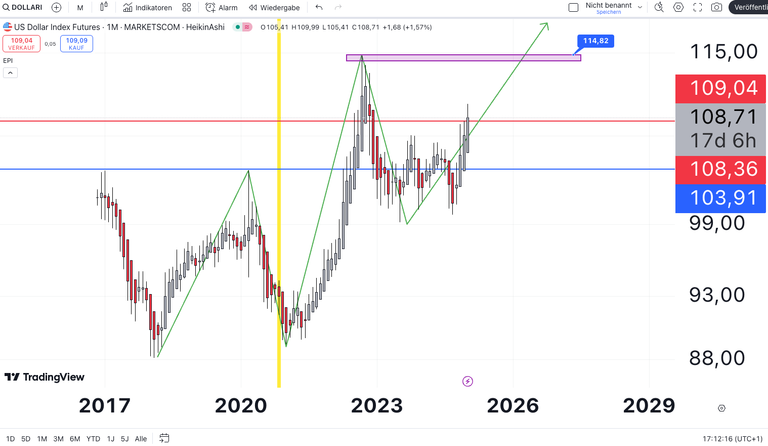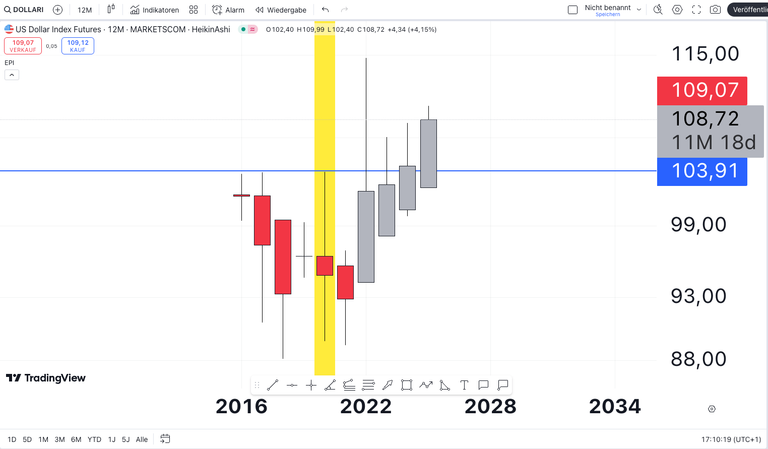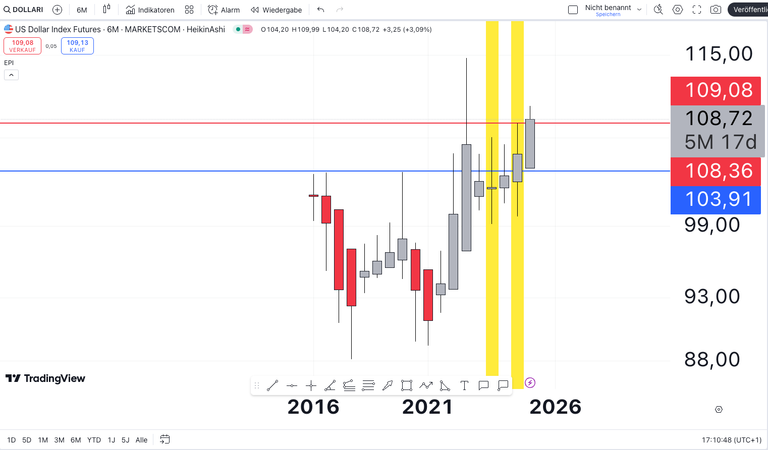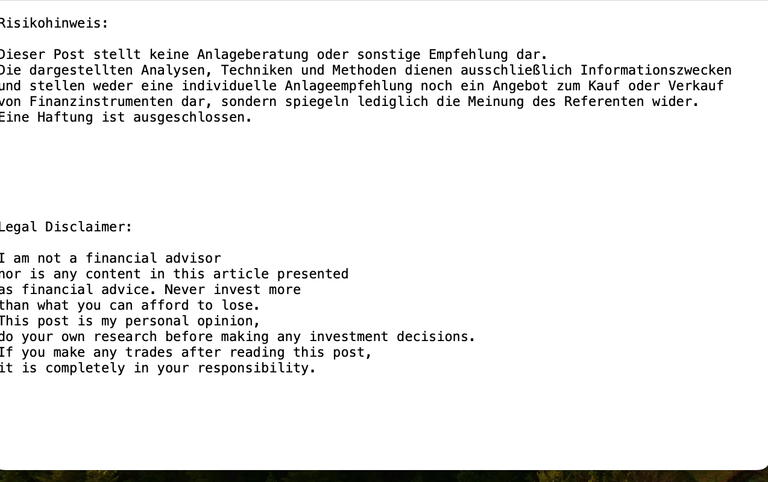Dollar Index Outlook / World Dept and rising Yields

Dollar Index on Month / possible breakout setup called Ballkönigin

Year PG Trigger 103

6 Month PG Trigger 109

The World is Indebted with an Increasing Trend
The Dollar Index shows a picture of potentially higher valuations and thus the dominance of the dollar in the world on larger time frames. The world is indebted in dollars, and currently, much of global trade depends on it. One reason for this dominance is the economic war, as we live in a world of de-globalization. Trade tariffs are the new nightmare for global players in the economy, as they complicate everything and make it much more expensive.
A global trader or producer must hoard dollars to exist in the world market. Trade restrictions and tariffs even encourage this. Small developing countries, whose currencies are subject to fluctuations, prefer to incur debt in dollars, as this is more predictable. However, what debts can trigger has often been documented and can destabilize a country.
The USA must take on about $100,000 in new debt every second. This means that national debt is growing rapidly, and the interest that must be paid on this debt is a significant financial burden on the government. According to current estimates, the annual interest burden of the USA exceeds one trillion dollars, accounting for about 28% of all budget expenditures. USA produces $6 million in new debt per minute.
The significant difference from the previous debt orgy starting in 2008 is that capital markets no longer believe in it and are now naturally demanding higher interest rates. The important ten-year Treasury bond from the USA is continuously rising, and it is questionable whether Trump can reverse this trend.
Ten-Year Treasury Bond USA:
| Year | Average Yield (%) |
|---|---|
| 2020 | 0.9 |
| 2021 | 1.5 |
| 2022 | 3.0 |
| 2023 | 3.95 |
| 2024 | 4.2 |
Explanations:
- 2020: Yields were low due to the COVID-19 pandemic and the associated economic uncertainties.
- 2021: A slow economic recovery led to an increase in yields.
- 2022: The Federal Reserve began raising interest rates, resulting in a significant rise in yields.
- 2023: The average yield was about 3.95%, as markets reacted to the Fed's monetary policy.
- 2024: The yield rose further to about 4.2%, reflecting ongoing inflation expectations.
The big question remains: How far can countries go into debt without destabilizing their own nation too much? For example, when looking at France or Italy, these countries have little choice but to hope for a debt union. A debt union is a bond market whose creditworthiness is determined by the strongest member—Germany, in this case. Germany would be the guarantor for all debts coming from the EU. Interest payments paralyze these countries since the interest rate is naturally high for borrowers in this category. Germany naturally pays low interest rates on new debts—but who knows for how long?
Debt-to-GDP Ratio by Country (in USD)
| Country | National Debt (in Trillions USD) | GDP (in Trillions USD) | Debt-to-GDP Ratio (%) |
|---|---|---|---|
| USA | 34.0 | 26.0 | 130.8 |
| Japan | 9.0 | 4.9 | 183.7 |
| China | 10.0 | 17.7 | 56.5 |
| Germany | 3.0 | 4.2 | 71.4 |
| France | 3.1 | 3.1 | 100.0 |
| Italy | 2.8 | 2.0 | 140.0 |
| India | 2.5 | 3.5 | 71.4 |
| Brazil | 1.5 | 2.1 | 71.4 |
| Canada | 1.0 | 2.1 | 47.6 |
| Australia | 0.8 | 1.5 | 53.3 |
| Russia | 0.6 | 1.7 | 35.3 |
| Spain | 1.5 | 1.4 | 107.1 |
| Mexico | 0.6 | 1.3 | 46.2 |
| South Korea | 0.9 | 1.6 | 56.3 |
| South Africa | 0.4 | 0.4 | 100.0 |
| Turkey | 0.5 | 0.9 | 55.6 |
Notes:
- The data provided is illustrative and may not reflect the most current statistics for each country.
- For accurate and updated figures, please refer to official financial reports or databases such as the World Bank or IMF.
- The debt figures are in trillions of USD, and the GDP figures are also in trillions of USD.

Die Welt ist verschuldet mit einer steigenden Tendenz
Der Dollar Index zeigt mir auf den ganz großen Zeiteinheiten ein Bild von eventuell noch höheren Bewertungen und somit der Dominanz vom Dollar in der Welt. Die Welt ist verschuldet in Dollar und derzeit ist viel vom Welthandel davon abhängig. Ein Grund für die Dominanz ist der Wirtschaftskrieg, denn wir leben in einer Welt, der De-Globalisierung. Handelszölle sind der neue Schrecken der globalen Player in der Wirtschaft, denn diese machen alles kompliziert und vor allen Dingen viel teurer.
Ein globaler Händler oder Produzent muss Dollar horten um auf dem Weltmarkt zu existieren. Handelsbeschränkungen und Zölle fördern dies sogar. Kleine Entwicklungsländer, deren Währung Schwankungen ausgesetzt ist, verschuldet sich lieber im Dollarraum, da dies kalkulierbar ist. Was Schulden allerdings auch auslösen können, ist oft dokumentiert worden und kann ein Land destabilisieren.
Die USA müssen pro Sekunde etwa 100.000 US-Dollar an neuen Schulden aufnehmen. Dies bedeutet, dass die Staatsverschuldung rasant wächst, und die Zinsen, die auf diese Schulden gezahlt werden müssen, sind ein erheblicher finanzieller Druck auf die Regierung. Laut aktuellen Schätzungen ist die jährliche Zinslast der USA über eine Billion Dollar, was etwa 28 % aller Haushaltsausgaben ausmacht.
USA produziert pro Minute 6 Millionen Dollar neue Schulden
Der große Unterschied zu der damaligen Schuldenorgie ab 2008 ist die Kapitalmärkte glauben dem ganzen nicht mehr und sie verlangen jetzt naturgemäß höhere Zinsen. Die wichtige zehnjährige Anleihe aus den USA steigt kontinuierlich, und es ist fraglich, ob Trump diesen Trend umkehren kann.
Zehnjährige Anleihe. USA:
| Jahr | Durchschnittliche Rendite (%) |
|---|---|
| 2020 | 0,9 |
| 2021 | 1,5 |
| 2022 | 3,0 |
| 2023 | 3,95 |
| 2024 | 4,2 |
Erläuterungen:
- 2020: Die Renditen waren aufgrund der COVID-19-Pandemie und der damit verbundenen wirtschaftlichen Unsicherheiten niedrig.
- 2021: Eine langsame Erholung der Wirtschaft führte zu einem Anstieg der Renditen.
- 2022: Die Federal Reserve begann, die Zinsen zu erhöhen, was zu einem signifikanten Anstieg der Renditen führte.
- 2023: Die durchschnittliche Rendite betrug etwa 3,95 %, da die Märkte auf die Geldpolitik der Fed reagierten.
- 2024: Die Rendite stieg weiter auf etwa 4,2 %, was die anhaltenden Inflationserwartungen widerspiegelt.
Die große Frage ist, wie weit können sich Länder verschulden ohne das eigene Land zu stark zu destabilisieren. Wenn ich mir beispielsweise Frankreich oder Italien ansehen, dann bleibt diesen Ländern nahezu nichts anderes übrig, als auf eine Schulden Union zu hoffen. Eine Schulden Union ist ein Zinsmarkt dessen Bonität vom stabilsten Mitglied entschieden wird und in diesem Falle wäre es Deutschland. Deutschland wäre in diesem Fall der Bürge für alle Schulden, die kommen aus der EU. Zinszahlungen lähmen diese Länder, da der Zinssatz naturgemäß hoch ist für Schuldner in dieser Kategorie. Deutschland zahlt naturgemäß wenig Zinsen für neue Schulden aber wer weiß, wie lange noch.
Debt-to-GDP Ratio by Country (in USD)
| Land | Staatsverschuldung (in Billionen USD) | BIP (in Billionen USD) | Verschuldungsgrad (%) |
|---|---|---|---|
| USA | 34.0 | 26.0 | 130.8 |
| Japan | 9.0 | 4.9 | 183.7 |
| China | 10.0 | 17.7 | 56.5 |
| Deutschland | 3.0 | 4.2 | 71.4 |
| Frankreich | 3.1 | 3.1 | 100.0 |
| Italien | 2.8 | 2.0 | 140.0 |
| Indien | 2.5 | 3.5 | 71.4 |
| Brasilien | 1.5 | 2.1 | 71.4 |
| Kanada | 1.0 | 2.1 | 47.6 |
| Australien | 0.8 | 1.5 | 53.3 |
| Russland | 0.6 | 1.7 | 35.3 |
| Spanien | 1.5 | 1.4 | 107.1 |
| Mexiko | 0.6 | 1.3 | 46.2 |
| Südkorea | 0.9 | 1.6 | 56.3 |
| Südafrika | 0.4 | 0.4 | 100.0 |
| Türkei | 0.5 | 0.9 | 55.6 |
Notes:
- The data provided is illustrative and may not reflect the most current statistics for each country.
- For accurate and updated figures, please refer to official financial reports or databases such as the World Bank or IMF.
- The debt figures are in billions of USD, and the GDP figures are also in billions of USD.

Citations:
[1] https://www.gold.de/staatsverschuldung-usa/
[2] https://www.bmeia.gv.at/reise-services/laender-a-bis-z
[3] https://de.statista.com/statistik/daten/studie/1975/umfrage/staatsverschuldung-der-usa/
[4] https://de.wikipedia.org/wiki/Liste_der_Staaten_der_Erde
[5] https://www.metzler.com/de/metzler/private-banking/artikel-pb/news/Metzler/MAM/markt-aktuell/2024-Jahresausblick-Staatsschulden
[6] https://www.aktion-deutschland-hilft.de/de/fachthemen/alle-laender-der-welt/
[7] https://www.gtai.de/de/trade/usa/wirtschaftsumfeld/staatsverschuldung-in-den-usa-laeuft-aus-dem-ruder-1067344
[8] https://www.fr.de/wirtschaft/staatsschulden-auf-rekordkurs-oekonomen-befuerchten-weltweite-finanzkrise-zr-93215868.html
As long as debt was put in good use (e.g. infrastructure building, technology investments). If government raised money through debt but the funds were plundered by politicians, then that's when things spiral on the way down.
The question is how much debt is still possible without going under due to the interest burden. After all, those backing the new debt want to be properly compensated for their risk, regardless of what the borrower intends to spend the money on